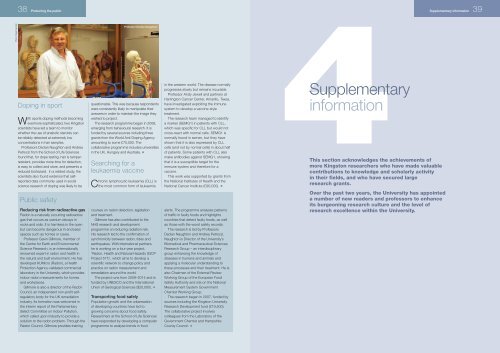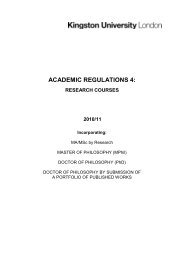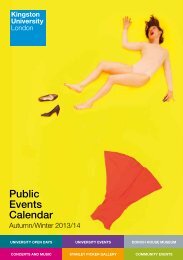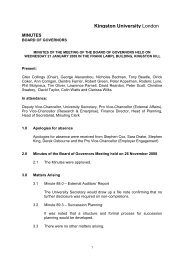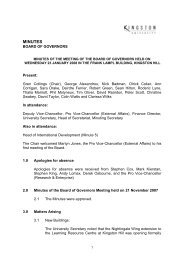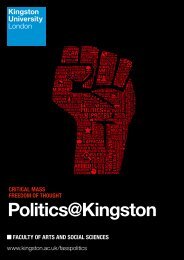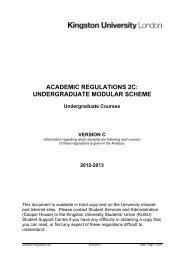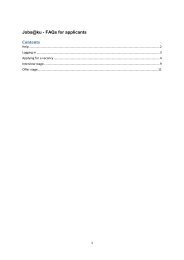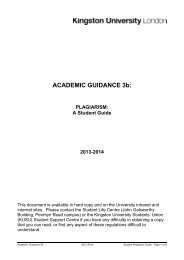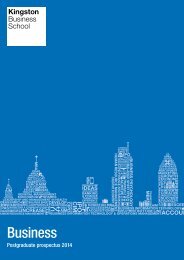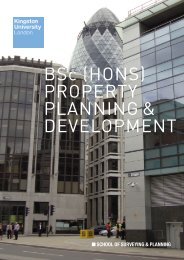Kingston research - Kingston University
Kingston research - Kingston University
Kingston research - Kingston University
Create successful ePaper yourself
Turn your PDF publications into a flip-book with our unique Google optimized e-Paper software.
20 Collaborations Collaborations<br />
21<br />
Behind the scenes at the<br />
Natural History Museum<br />
Museum staff build up a personal body of information during the course of their<br />
work. Their knowledge of collection development, methodologies, history, exhibitions<br />
and staffing constitute an important cultural resource. Over a period of five years,<br />
24 staff are retiring from the Natural History Museum, taking with them 775 years<br />
of experience. Many of these staff are world leaders in their scientific fields.<br />
Their knowledge is of huge importance to many disciplines yet the Museum<br />
had no sustained programme to capture their knowledge and experience.<br />
The ‘Museum Lives’ collaboration aims to rectify this.<br />
Professor Brian Cathcart, principal investigator,<br />
“Museum Lives”<br />
In a three-year partnership with the<br />
Museum, a team from <strong>Kingston</strong><br />
<strong>University</strong>’s Faculty of Arts and Social<br />
Sciences, led by Professor Brian<br />
Cathcart, is recording the memories and<br />
experiences of curators, collectors and<br />
other specialists. It will produce a detailed<br />
historical record and create multimedia<br />
resources for the Museum’s exhibitions and<br />
education work, which will add new<br />
dimensions to the collections and help<br />
attract fresh audiences.<br />
The project is creating filmed records<br />
relating to 50 Museum staff, as well as short<br />
films suitable for educational and exhibition<br />
use. The resource will be available on the<br />
Museum website and may also be used in<br />
public exhibitions, learning programmes and<br />
marketing. The material will be available to<br />
school and college students, artists,<br />
filmmakers, broadcasters, writers and poets.<br />
The Museum’s Director of Science<br />
Professor Richard Lane said: “Many of our<br />
senior <strong>research</strong>ers and curators have<br />
decades of experience in managing and<br />
engaging the public with the national<br />
collection of 70 million natural history<br />
specimens. This oral history project gives us<br />
additional tools with which to preserve this<br />
knowledge and share it with a much wider<br />
audience. Visitors and the wider public will<br />
get a new insight into the life and work of<br />
the Natural History Museum in a way they<br />
have never been able to before.”<br />
The long-term aim is to embed the<br />
programme in the Museum’s work so that<br />
preservation of knowledge<br />
becomes routine. Volunteer<br />
oral historians are being<br />
trained, staff will receive help in<br />
recording their memories and<br />
the project will stimulate the<br />
recovery of fading knowledge<br />
through ‘witness seminars’.<br />
‘Museum Lives’ grew out of the<br />
AHRC-funded ‘New Perspectives’ project<br />
which examined ways of encouraging<br />
academics in the arts and humanities to<br />
make better use of the Museum’s<br />
resources. <strong>Kingston</strong> <strong>University</strong>’s Faculty of<br />
Arts and Social Sciences and the Faculty of<br />
Health and Social Care Sciences had<br />
undertaken previous <strong>research</strong> in oral history<br />
methodologies in a project called ‘Nurses’<br />
Voices’ and already had the necessary<br />
expertise.<br />
‘Museum Lives’ is funded by the AHRC<br />
(£262,763). ◆<br />
Giving nurses a voice<br />
urses’ Voices’ captures the history of<br />
‘NSt George’s Hospital in London from<br />
the perspective of its nurses. More than 130<br />
interviews and 1,000 hours of recordings<br />
were generated for the project, featuring<br />
nurses and midwives who trained or worked<br />
at St George’s from around 1930 to the<br />
present day.<br />
The project was run by the Faculty of<br />
Health and Social Care Sciences. By asking<br />
pertinent questions and recording personal<br />
experiences, it captures a richness of<br />
personal experience that cannot be gained<br />
from written records. Interviewees were<br />
asked questions such as: How did it feel to<br />
work in healthcare at the introduction of the<br />
National Health Service? Which clinical<br />
practices were undertaken before the<br />
general availability of antibiotics, in the early<br />
days of cardiac surgery and pacemakers,<br />
and as the brain scanner was being<br />
developed at Atkinson Morley’s Hospital?<br />
What were the people like to work with?<br />
The original team was subsequently<br />
commissioned to work with the Florence<br />
Nightingale Museum to create ‘Hospital<br />
A detail of the skull of Allosaurus, on display at the<br />
Natural History Museum, London<br />
Voices’, an oral history archive of the<br />
memories and experiences of nurses and<br />
patients at London’s Guy’s and St Thomas’<br />
Hospital from 1930. The team have also<br />
worked with the League of St Bartholomew’s<br />
Nurses to create an oral history archive from<br />
which a celebratory DVD of the nurses’<br />
memories has been created. ◆<br />
Photo: © The Natural History Museum, London


